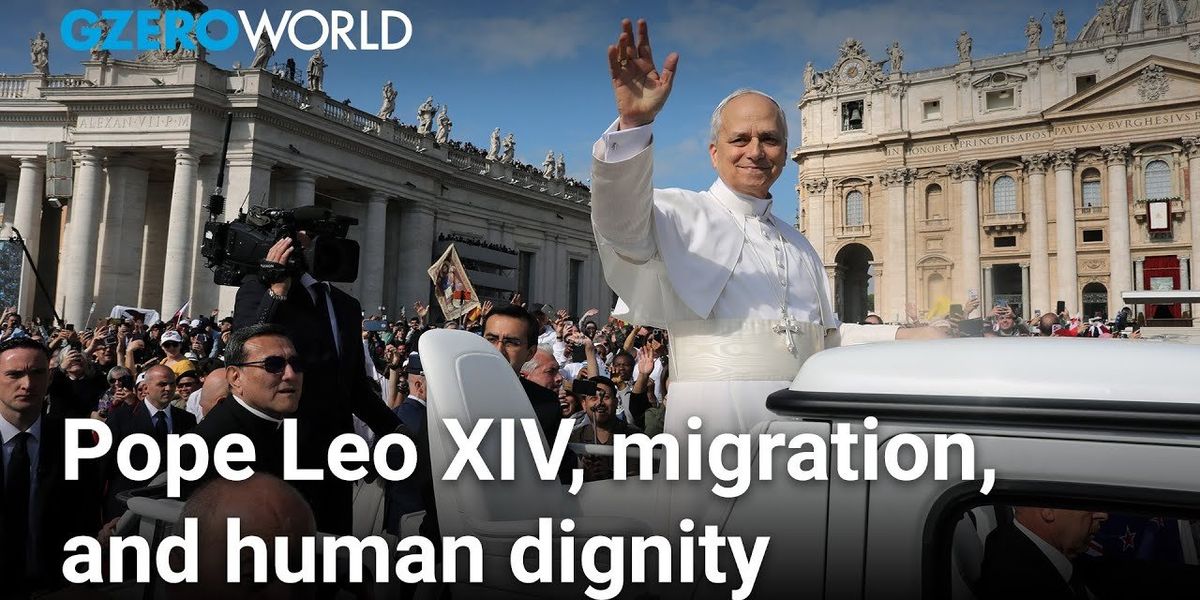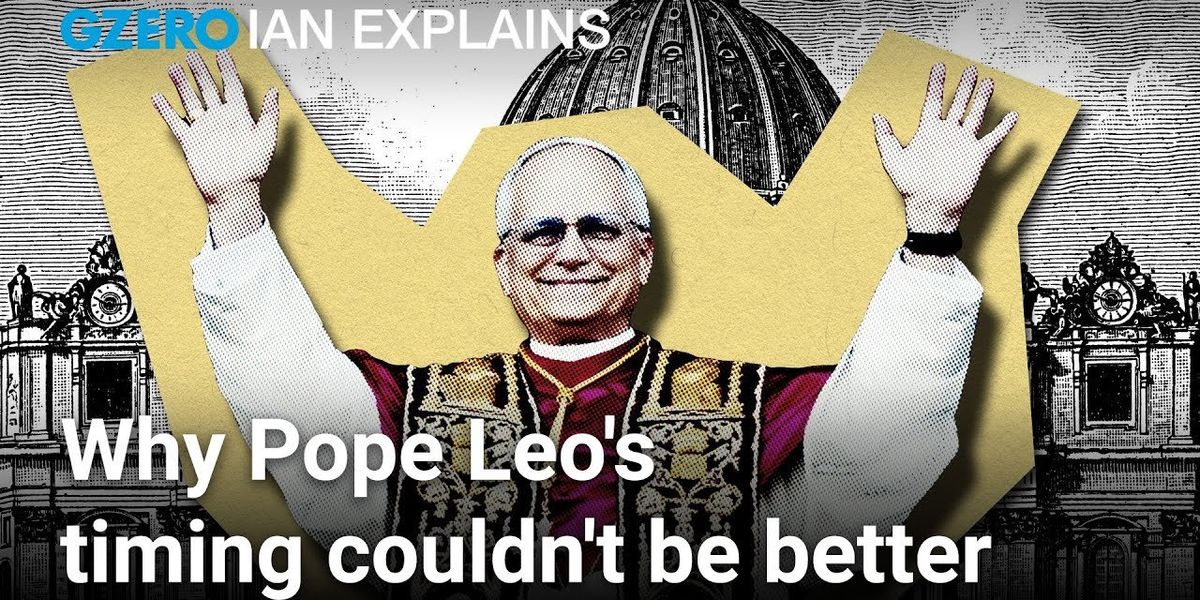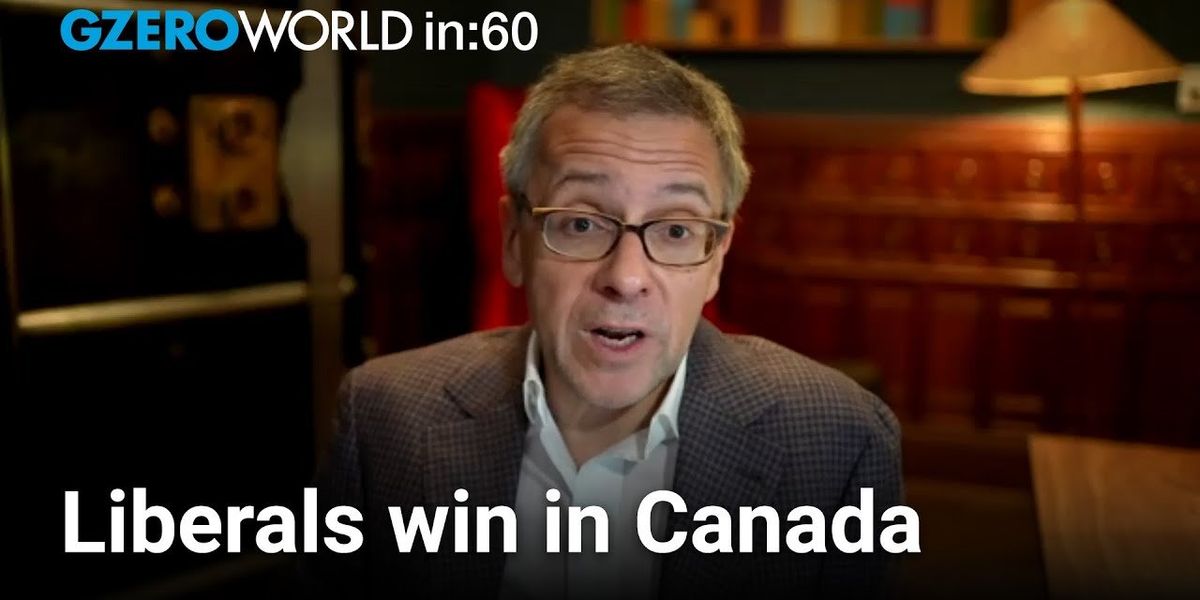Trending Now
We have updated our Privacy Policy and Terms of Use for Eurasia Group and its affiliates, including GZERO Media, to clarify the types of data we collect, how we collect it, how we use data and with whom we share data. By using our website you consent to our Terms and Conditions and Privacy Policy, including the transfer of your personal data to the United States from your country of residence, and our use of cookies described in our Cookie Policy.
{{ subpage.title }}
On immigration, Pope Leo XIV will advocate for the "dignity of the human" says Fr. James Martin
As part of a larger conversation about the role of religion in modern politics and society, Father James Martin discusses Pope Leo's approach to immigration. Then Father Martin reflects on his own advocacy for LGBTQ issues, emphasizing the Gospel's moral imperative over political convenience.
When it comes to migration, Martin says the Pope’s stance isn’t political, it’s biblical: “His orientation is the Gospel, and the Gospel talks about welcoming the stranger.” He pushes back against Vice President JD Vance's interpretation of "love thy neighbor," noting that Catholic teaching calls on people to care for those they don't know. While the Vatican usually avoids direct political confrontation, Martin says sometimes "directness is called for."
Later, Martin turns to the cultural backlash against transgender people, especially in the US, saying the Church’s call is clear: accompany and affirm their dignity. "The more that they are attacked, the more urgent it becomes for us to stand with them," he says. He points to the late Pope Francis’s quiet but consistent engagement with the trans community as a model of compassion over doctrine.
In both cases, Martin underscores the same theme: whether the issue is immigration or gender identity, the Church's mission is to recognize and protect the dignity of every person.
GZERO World with Ian Bremmer, the award-winning weekly global affairs series, airs nationwide on US public television stations (check local listings).
New digital episodes of GZERO World are released every Monday on YouTube. Don't miss an episode: subscribe to GZERO's YouTube channel and turn on notifications (🔔).GZERO World with Ian Bremmer airs on US public television weekly - check local listings.
Pope Leo XIV's historic opportunity, with Father James Martin
Listen: Ian Bremmer sits down with Jesuit priest and bestselling author Father James Martin to talk about the historic ascendancy of Pope Leo XIV—the first-ever US Pope—and what his papacy means for the Catholic Church, American politics, and a world in search of moral clarity.
Known for his humility and prayerful presence, Marin says Pope Leo has would do well to make his top priority healing internal divisions within the Church. “There’s a lot of division and anger,” Martin says, “but Pope Leo has the opportunity to build bridges between progressives and traditionalists.” And his early comments on war and migration signal that he intends to take moral stances with global relevance—including the Church’s firm position on welcoming the stranger. “When Jesus says, ‘When you welcome the stranger, you welcome me,’ that’s pretty clear,” Martin says.
Martin also speaks about his own public advocacy for LGBTQ Catholics, especially trans people, who he says are “being treated like dirt.” The conversation also turns to the legacy of Pope Francis, whose pastoral outreach—from encyclicals on climate change to nightly calls with Gaza parishioners—inspired many, including his successor. “Francis showed us that the Church is a field hospital,” Martin says.
GZERO World with Ian Bremmer, the award-winning weekly global affairs series, airs nationwide on US public television stations (check local listings).
New digital episodes of GZERO World are released every Monday on YouTube. Don't miss an episode: subscribe to GZERO's YouTube channel and turn on notifications (🔔).GZERO World with Ian Bremmer airs on US public television weekly - check local listings.
The US has its first Pope, and a renewed openness to religion
Ian Bremmer The US has experienced a steady, long-term decline religiousness, with Gallup showing less than half of Americans belong to a house of worship today. But spirituality in the US remains surprisingly resilient.
Bremmer unpacks America's longstanding slide into secularism contrasted with a recent renewed interest in religion. Drawing from two key surveys, Bremmer contrasts Gallup's data on religion’s erosion since the 1960s with a massive Pew study that suggests a recent leveling-off in Christian affiliation and consistent rates of prayer and service attendance over the past few years.
“Americans today are as spiritual as they’ve ever been,” Bremmer notes, even if fewer of them are going to church. With political polarization and social isolation on the rise, he explores whether religion might be on the brink of a cultural comeback—not just as dogma, but as a renewed search for meaning and connection.
GZERO World with Ian Bremmer, the award-winning weekly global affairs series, airs nationwide on US public television stations (check local listings).
New digital episodes of GZERO World are released every Monday on YouTube. Don't miss an episode: subscribe to GZERO's YouTube channel and turn on notifications (🔔).GZERO World with Ian Bremmer airs on US public television weekly - check local listings.
The Graphic Truth: Who’s choosing the next pope?
The conclave to select a new pontiff gets underway on May 7, 2025.
Who selects the next pope? Roman Catholic cardinals, and there are 252 of them worldwide, but only 135 are under the age of 80 and thus eligible to vote for the successor to Pope Francis. Two of them, Antonio Cañizares of Spain and John Njue of Kenya, cannot attend, and of the 133 electors participating, Francis appointed 108 of them.
Is there a list of contenders? The cardinals can vote for their preferred colleague to take the top spot at the Vatican, and there’s no official shortlist of candidates. But there are a handful who are considered frontrunners — our sources say to look at French Cardinal Jean-Marc Aveline and Filipino Cardinal Luis Antonio Tagle on the progressive end, and the Italian Cardinals Pierbattista Pizzaballa and Pietro Parolin for the conservatives.
All eyes will be on how the trajectory of the largest religious institution in world history shifts under a new pope.
Why Mark Carney’s victory won’t heal the US-Canada rift
Ian Bremmer shares his insights on global politics this week on World In :60.
Mark Carney leads the Liberals to victory in Canada. So, what's next for the US-Canada relationship?
I think sometimes you have relationship with somebody, and they do something that shocks you, you can't unsee it, I think US-Canada is like that now. I think the damage is permanent. Of course, the interdependence is immense. The dependence on the Canadian side is higher. They're a much smaller country. Their population is right next to the United States. Just a thin strip there. So, it's not like you can suddenly decouple, but there's going to be a lot of de-risking. So, strong efforts, very tough negotiations coming on trade and on security, but also an effort to build infrastructure and ship Canadian resources away from the United States, towards other countries around the world. Medium-term, that's going to be a pretty significant change in how we think about Canada.
The conclave will pick the next pope. How is it relevant for the wider geopolitical landscape?
It's relevant because, increasingly, political leaders do not inspire. So, here you have a population as large as any country, about 1.4 billion Catholics all over the world, just like India, just like China. That's the size of the global population. If the next pope that is picked is someone who is inspirational, is someone that is seen as a 21st century leader that can reflect sensibilities and ideology, values that are not seen from political leaders around the world, in your own countries, then the ability to have an impact on what gets young people out, and motivated, and inspired and engaged in public service or on the streets, and mobilized, and demonstrating becomes significant. So, I do think there's a real opportunity here, but we'll see what it means when we finally see white smoke coming out of the Vatican.
Ukrainian President Volodymyr Zelensky and US President Donald Trump meet while they attend the funeral of Pope Francis at the Vatican on April 26, 2025.
Funeral diplomacy: World leaders push for peace in Rome
Has the pope’s funeral set the stage for peace in Ukraine? At the Vatican on Saturday, US President Donald Trump sat down with Ukrainian President Volodymyr Zelensky for a meeting the White House described as “very productive,” and which Zelensky said had the “potential to become historic, if we achieve joint results.” Zelensky also met separately with Italian Prime Minister Giorgia Meloni, UK Prime Minister Keir Starmer, and French President Emmanuel Macron, who later claimed that Ukraine was ready for an “unconditional ceasefire” and that it’s “now up to Russia to prove that it truly wants to end this war.”
Trump also threw the ball into Russia’s court – but it landed more like a grenade. After meeting Zelensky, the US President posted to Truth Social that he feared Russian President Vladimir Putin might have been “tapping” – aka, deceiving – him about his willingness to end the war. The evidence? Russia’s continued bombardment of Ukraine, including an attack Thursday that killed 12 people and injured 90. Trump suggested that now Putin must be “dealt with differently,” possibly through banking or secondary sanctions. At the same time, the US president claimed late Sunday that Ukraine was ready to yield Crimea – Zelensky said last week this was a nonstarter.
The response? Hours later, Russia launched a large-scale drone and airstrike assault across Ukraine, killing at least four people and injuring several others. Each country also targeted the other overnight with long-range attacks, though there were no immediate reports of casualties. Mediators are now urging the two sides to the table in what US Secretary of State Marco Rubio described as a “critical week” for resolving the conflict.
Oh and by the way. Though it had been known for some time, North Korea formally acknowledged on Sunday that it has been lending troops to the Russian cause. Separately, the Trump administration is reportedly looking to reopen talks with the North Korean regime, after Trump held a pair of talks with Kim Jong Un during his first term in office.The body of Pope Francis in the coffin exposed in St. Peter's Basilica in Vatican City on April 24, 2025. The funeral will be celebrated on Saturday in St. Peter's Square.
World leaders to bid farewell to Pope Francis – and hold talks on the side
While the Catholic world prepares for the funeral of Pope Francis on Saturday – the service begins at 10 a.m. local time, 4 a.m. ET – certain high-profile attendees may also have other things on their mind. Several world leaders will be on hand to pay their respects to the pontiff, but they could also find themselves involved in bilateral talks.
Who’s on the list? Italian Prime Minister Giorgia Meloni will effectively be the host at the Vatican, which lies just next to Rome. Many of her fellow Western leaders will attend, including French President Emmanuel Macron, German Chancellor Olaf Scholz, Ukrainian President Volodomyr Zelensky, UK Prime Minister Keir Starmer, and US President Donald Trump. Philippine President Ferdinand Marcos Jr., who leads the most Catholic country in Asia, will also attend.
South American representation. Argentine President Javier Milei – a former adversary of Francis, his fellow countryman – and Brazilian President Luiz Inácio Lula da Silva plan to cross the Atlantic for the funeral, too.
Glaring omission. Russian President Vladimir Putin won’t attend the funeral, the Kremlin confirmed.
Side hustle. Trump appears to be the principal object of interest for other world leaders. Zelensky has already said that he’d like to speak to the US president at the Vatican, while European Commission President Ursula von der Leyen could meet the American president for the first time since he returned to office, if Meloni gets her way. They won’t have much time, though: Trump plans to spend less than 24 hours in Rome.
Nuns and faithful attend a rosary for Pope Francis, following the death of the pontiff, in St. Peter's square, at the Vatican, April 21, 2025.
World bids farewell to Pope Francis, awaits conclave’s choice
Preparations for the funeral of Pope Francis are underway after the Holy Father died from a cerebral stroke early Monday – as are those for the secretive election to choose his successor.
The funeral date has been set for Saturday. Tens of thousands attended the funeral of Francis’ predecessor, Benedict XVI, in 2022, who had retired in 2013. When John Paul II died in 2005, some four million people paid their respects. This time, leaders from around the globe are expected to attend, including Donald Trump, who is set to become the first sitting US president to attend a papal funeral since 2005.
Francis will be dressed in red regalia, and his ring of office will be ceremonially destroyed, but much of the proceedings will break from tradition: He ordered that he be laid to rest in a simple coffin and interred in Santa Maria Maggiore, not the Vatican grottoes.
Choosing a successor. Within 20 days, Catholic cardinals under the age of 80 (135 out of 252) will gather in the Sistine Chapel to choose the next pope. The conclave – from a Latin root meaning “with keys” – is shut off from the wider world, a measure deemed necessary after medieval interregna lasted months or years due to secular political meddling.
There are no guarantees, but the electoral math points to a potentially short contest: 108 of the 135 eligible elector cardinals were appointed by Francis and may quickly assemble the necessary two-thirds consensus around a successor with similarly progressive values.

